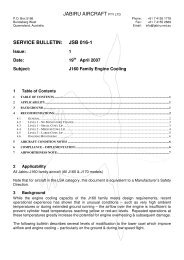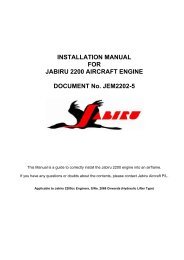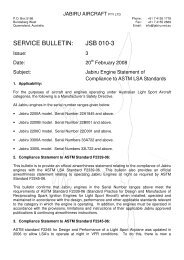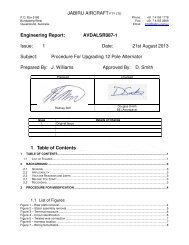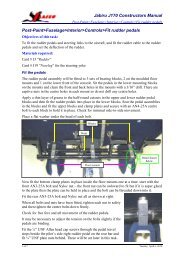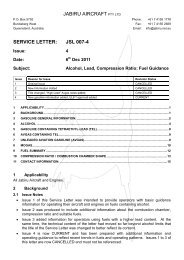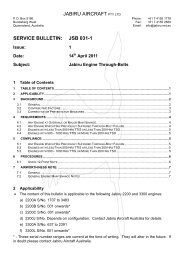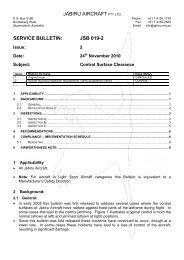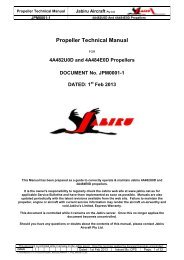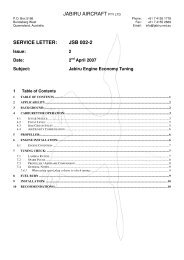INSTRUCTION AND MAINTENANCE MANUAL FOR JABIRU 2200 ...
INSTRUCTION AND MAINTENANCE MANUAL FOR JABIRU 2200 ...
INSTRUCTION AND MAINTENANCE MANUAL FOR JABIRU 2200 ...
You also want an ePaper? Increase the reach of your titles
YUMPU automatically turns print PDFs into web optimized ePapers that Google loves.
Jabiru Aircraft Pty LtdInstruction & Maintenance ManualJabiru <strong>2200</strong> Aircraft EngineHydraulic Valve Lifter ModelsEITHER – Remove each rocker cover and check that each lifter has not collapsed.This is done by turning the crankshaft so that the valve is fully in the closed position,then feeling the rocker by hand. There should be no free rotation of the rocker. Pressdown on the pushrod end of the rocker – the lifter should feel hard, with minimalmovement possible under thumb pressure. Note that the correct method for findingthis point is to turn the crank until the valve is fully open, then turning the crankshaftthrough one complete revolution to rotate the cam lobe away from the lifter.OR – after the service, idle the engine, listen for loud tapping noises and feel for roughrunning. This must be carried out with the cowls removed. Note that due to the needto have a person at the controls of the aircraft, this is a two-person job.CAUTION:While ever the engine is running there must be a qualified person inside the aircraft,at the controls. Under NO circumstances run the engine without a qualified personat the controls. Troubleshooting information is given in Section 14.1.11Air can be caught inside the lifters after maintenance. Running the engine at a highidle - approx 1500 RPM – will expel the air but may take up to 15 minutes. Whenfitting lifters after inspection or maintenance they should be filled by injecting oil intothe hole in the side of the lifter. Care must be taken to ensure all air is removed.Several different hydraulic lifters have been used in Jabiru <strong>2200</strong> engines. The camP/No. fitted to the engine must be known when ordering replacement lifters. Thisinformation can be found from the engine’s S/No. or from it’s overhaul records.The type of lifter must be matched correctly to the cam design. Use of mismatchedparts will cause reduced engine power and possible engine damage.Figure 7 shows identification markings on a P/No. 4A432A0D cam – it has two “rings”machined at the oil pump end and two small “spots” machined at the drive gear end.Similarly, P/No. 4A430A0D cams are marked with one “ring”, and one “spot”. Enginesassembled with these cam types must use a Jabiru P/No. PE4A001 Hydraulic Lifter.These cams are standard in engines with S/No. 22A-2850 & 22C-001 onwards.Cams manufactured without any identification “rings” or “spots” must use a JabiruP/No. 4A294C0D Hydraulic Lifter.The different types of Hydraulic Lifter are not marked and the difference requiresdisassembly and careful measuring using a micrometer to detect. Accordingly, caremust be taken to ensure different types of lifter are not confused during maintenance.This document is controlled while it remains on the Jabiru server. Once this no longer applies the document becomes uncontrolled.REVISION 0 1 2 3 4 5 6 7 8 9 Dated : June 2010 Issued By: DPS Page: 32 of 116L:\files\Manuals_For_Products\Engine_Manuals\Transition\JEM2204-9_I&M_unsigned.docx





